Application of Artificial Neural Networks in Construction Management: Current Status and Future Directions
Abstract
:1. Introduction
2. Artificial Neural Networks
3. Research Methodology
3.1. Data Collection
3.1.1. Journal Selection
3.1.2. Article Selection
3.2. Content Analysis
4. Results of Content Analysis
4.1. Publication Trend of Research on ANN in CM from 2000 to 2020
4.2. Types of ANN Applied in CM Research
4.3. Methods Integrated with ANN Applied in CM Research
4.4. Application Fields and Hot Topics on ANN in CM
4.5. Stages and Perspectives
5. Discussions and Future Directions
5.1. Progress for ANN in CM
5.2. Challenges and Future Directions for ANN in CM
5.2.1. Model Development and Application
5.2.2. Data Availability
5.2.3. Application Field Exploration
5.2.4. The Introduction of Emerging Technologies
6. Conclusions
Author Contributions
Funding
Institutional Review Board Statement
Informed Consent Statement
Data Availability Statement
Conflicts of Interest
Abbreviations
| ABNN | Adaptive boosting neural networks |
| AC | Automation in construction |
| AI | Artificial intelligence |
| ANN | Artificial neural networks |
| BANN | Bootstrap aggregating neural networks |
| BIM | Building Information Modeling |
| BPNN | Back-propagation neural network |
| CM | Construction management |
| CNN | Convolutional neural network |
| ECAM | Engineering, Construction, and Architectural Management |
| ERP | enterprise resource planning |
| FFNN | Feed-forward neural network |
| FL | Fuzzy logic |
| GA | Genetic algorithms |
| GIS | Geographic information systems |
| GRNN | General regression neural network |
| GUI | Graphical user interface |
| IJPM | International Journal of Project Management |
| IoT | Internet of Things |
| JCCE | Journal of Computing in Civil Engineering |
| JCEM | Journal of Construction Engineering and Management |
| JCiEM | Journal of Civil Engineering and Management |
| JME | Journal of Management in Engineering |
| LCC | Life cycle costs |
| MLPNN | Multilayer perceptron neural networks |
| NNA | Neural network autoregression |
| PMBOK | Project Management Body of Knowledge |
| PMI | Project Management Institute |
| PNN | Probabilistic neural network |
| QNN | Quantile neural networks |
| RBFNN | Radial basis function (RBF) neural networks |
| RFID | Radio frequency identification devices |
| TDNN | Time delay neural network |
| WNN | Wavelet neural network |
References
- You, Z.; Wu, C. A framework for data-driven informatization of the construction company. Adv. Eng. Inform. 2019, 39, 269–277. [Google Scholar] [CrossRef]
- Busta, H. KPMG Report: Construction Industry Slow to Adopt New Technology. 2016. Available online: Constructiondive.com (accessed on 15 January 2021).
- Manyika, J.; Lund, S.; Bughin, J.; Woetzel, J.; Stamenov, K.; Dhingra, D. Digital Globalization: The New Era of Global Flows; DhingraMcKinsey & Company: New York, NY, USA, 2016. [Google Scholar]
- Deng, H.; Hong, H.; Luo, D.H.; Deng, Y.C.; Su, C. Automatic Indoor Construction Process Monitoring for Tiles Based on BIM and Computer Vision. J. Constr. Eng. Manag. 2020, 146, 04019095. [Google Scholar] [CrossRef]
- Yx, A.; Ying, Z.B.; Psc, D.; Ld, B. Machine learning in construction: From shallow to deep learning. Dev. Built Environ. 2021, 6, 100045. [Google Scholar] [CrossRef]
- Sun, H.; Burton, H.; Huang, H. Machine Learning Applications for Building Structural Design and Performance Assessment: State-of-the-Art Review. J. Build. Eng. 2020, 33, 101816. [Google Scholar] [CrossRef]
- Shehadeh, A.; Alshboul, O.; Al Mamlook, R.E.; Hamedat, O. Machine learning models for predicting the residual value of heavy construction equipment: An evaluation of modified decision tree, LightGBM, and XGBoost regression. Autom. Constr. 2021, 129, 103827. [Google Scholar] [CrossRef]
- Ruggieri, S.; Cardellicchio, A.; Leggieri, V.; Uva, G. Machine-learning based vulnerability analysis of existing buildings. Autom. Constr. 2021, 132, 103936. [Google Scholar] [CrossRef]
- Lesniak, A.; Juszczyk, M. Prediction of site overhead costs with the use of artificial neural network based model. Arch. Civ. Mech. Eng. 2018, 18, 973–982. [Google Scholar] [CrossRef]
- Patel, D.A.; Jha, K.N. Neural Network Model for the Prediction of Safe Work Behavior in Construction Projects. J. Constr. Eng. Manag. 2015, 141, 04014066. [Google Scholar] [CrossRef]
- Chao, L.C.; Skibniewski, M.J. Neural-Network Method of Estimating Construction Technology Acceptability. J. Constr. Eng. Manag.-ASCE 1995, 121, 130–142. [Google Scholar] [CrossRef]
- Juszczyk, M.; Zima, K.; Lelek, W. Forecasting of sports fields construction costs aided by ensembles of neural networks. J. Civ. Eng. Manag. 2019, 25, 715–729. [Google Scholar] [CrossRef] [Green Version]
- Turkan, Y.; Hong, J.; Laflamme, S.; Puri, N. Adaptive wavelet neural network for terrestrial laser scanner-based crack detection. Autom. Constr. 2018, 94, 191–202. [Google Scholar] [CrossRef] [Green Version]
- Darko, A.; Chan, A.P.C.; Adabre, M.A.; Edwards, D.J.; Hosseini, M.R.; Ameyaw, E.E. Artificial intelligence in the AEC industry: Scientometric analysis and visualization of research activities. Autom. Constr. 2020, 112. [Google Scholar] [CrossRef]
- Sony, S.; Dunphy, K.; Sadhu, A.; Capretz, M. A systematic review of convolutional neural network-based structural condition assessment techniques. Eng. Struct. 2021, 226. [Google Scholar] [CrossRef]
- Pan, Y.; Zhang, L.M. Roles of artificial intelligence in construction engineering and management: A critical review and future trends. Autom. Constr. 2021, 122, 41–52. [Google Scholar] [CrossRef]
- Adeli, H. Neural networks in civil engineering: 1989–2000. Comput.-Aided. Civ. Inf. 2001, 16, 126–142. [Google Scholar] [CrossRef]
- Buscema, M. A brief overview and introduction to artificial neural networks. Subst. Use Misuse 2002, 37, 1093–1148. [Google Scholar] [CrossRef]
- Zou, J.; Han, Y.; So, S.-S. Overview of Artificial Neural Networks. In Artificial Neural Networks: Methods and Applications; Livingstone, D.J., Ed.; Humana Press: Totowa, NJ, USA, 2009; pp. 14–22. [Google Scholar]
- Bougrain, L. Practical Introduction to Artificial Neural Networks. IFAC Proc. Vol. 2004, 37, 347–352. [Google Scholar] [CrossRef] [Green Version]
- Boussabaine, A.H. The use of artificial neural networks in construction management: A review. Constr. Manag. Econ. 1996, 14, 427–436. [Google Scholar] [CrossRef]
- Cao, B.; Zhang, K.C.; Wei, B.; Chen, L. Status quo and future prospects of artificial neural network from the perspective of gastroenterologists. World J. Gastroenterol. 2021, 27, 2681–2709. [Google Scholar] [CrossRef] [PubMed]
- Wang, D.; Arditi, D.; Damci, A. Construction Project Managers’ Motivators and Human Values. J. Constr. Eng. Manag. 2017, 143. [Google Scholar] [CrossRef]
- Shariati, M.; Mafipour, M.S.; Mehrabi, P.; Bahadori, A.; Zandi, Y.; Salih, M.N.A.; Hoang, N.; Dou, J.; Song, X.; Poi-Ngian, S. Application of a Hybrid Artificial Neural Network-Particle Swarm Optimization (ANN-PSO) Model in Behavior Prediction of Channel Shear Connectors Embedded in Normal and High-Strength Concrete. Appl. Sci. 2019, 9, 5534. [Google Scholar] [CrossRef] [Green Version]
- Garg, N.; Dhruw, S.; Gandhi, L. Prediction of Sound Insulation of Sandwich Partition Panels by Means of Artificial Neural Networks. Arch. Acoust. 2017, 42, 643–651. [Google Scholar] [CrossRef] [Green Version]
- Wang, X.; Lu, H.F.; Wei, X.J.; Wei, G.; Behbahani, S.S.; Iseley, T. Application of Artificial Neural Network in Tunnel Engineering: A Systematic Review. IEEE Access 2020, 8, 119527–119543. [Google Scholar] [CrossRef]
- Prieto, A.; Prieto, B.; Ortigosa, E.M.; Ros, E.; Pelayo, F.; Ortega, J.; Rojas, I. Neural networks: An overview of early research, current frameworks and new challenges. Neurocomputing 2016, 214, 242–268. [Google Scholar] [CrossRef]
- Kumar, R.; Aggarwal, R.K.; Sharma, J.D. Energy analysis of a building using artificial neural network: A review. Energy Build. 2013, 65, 352–358. [Google Scholar] [CrossRef]
- Krippendorff, K. Content Analysis: An Introduction to Its Methodology, 3rd ed.; SAGE: Los Angeles, CA, USA, 2013. [Google Scholar]
- Chan, A.; Chan, D.; Yeung, J. Overview of the Application of “Fuzzy Techniques” in Construction Management Research. J. Constr. Eng. Manag. 2009, 135, 1241–1252. [Google Scholar] [CrossRef] [Green Version]
- Hu, X.; Xia, B.; Skitmore, M.; Chen, Q. The application of case-based reasoning in construction management research: An overview. Autom. Constr. 2016, 72, 65–74. [Google Scholar] [CrossRef] [Green Version]
- Xiong, B.; Skitmore, M.; Xia, B. A critical review of structural equation modeling applications in construction research. Autom. Constr. 2015, 49, 59–70. [Google Scholar] [CrossRef] [Green Version]
- Yang, J.; Shen, G.Q.; Ho, M.F.; Drew, D.S.; Xue, X.L. Stakeholder management in construction: An empirical study to address research gaps in previous studies. Int. J. Proj. Manag. 2011, 29, 900–910. [Google Scholar] [CrossRef]
- Neto, D.d.C.e.S.; Cruz, C.O.; Rodrigues, F.; Silva, P. Bibliometric Analysis of PPP and PFI Literature: Overview of 25 Years of Research. J. Constr. Eng. Manag. 2016, 142. [Google Scholar] [CrossRef]
- Hosseini, M.R.; Martek, I.; Zavadskas, E.K.; Aibinu, A.A.; Arashpour, M.; Chileshe, N. Critical evaluation of off-site construction research: A Scientometric analysis. Autom. Constr. 2018, 87, 235–247. [Google Scholar] [CrossRef]
- Siraj, N.B.; Fayek, A.R. Risk Identification and Common Risks in Construction: Literature Review and Content Analysis. J. Constr. Eng. Manag. 2019, 145. [Google Scholar] [CrossRef]
- Wing, C.K. The ranking of construction management journals. Constr. Manag. Econ. 1997, 15, 387–398. [Google Scholar] [CrossRef]
- Araujo, A.G.; Pereira Carneiro, A.M.; Palha, R.P. Sustainable construction management: A systematic review of the literature with meta-analysis. J. Clean. Prod. 2020, 256, 120350. [Google Scholar] [CrossRef]
- Santos, R.; Costa, A.A.; Grilo, A. Bibliometric analysis and review of Building Information Modelling literature published between 2005 and 2015. Autom. Constr. 2017, 80, 118–136. [Google Scholar] [CrossRef]
- Zhao, X. A scientometric review of global BIM research: Analysis and visualization. Autom. Constr. 2017, 80, 37–47. [Google Scholar] [CrossRef]
- Liu, M.; Le, Y.; Hu, Y.; Xia, B.; Gao, X. System dynamics modeling for construction management research: Critical review and future trends. J. Civ. Eng. Manag. 2019, 25, 730–741. [Google Scholar] [CrossRef] [Green Version]
- Sousa, V.; Matos, J.P.; Matias, N. Evaluation of artificial intelligence tool performance and uncertainty for predicting sewer structural condition. Autom. Constr. 2014, 44, 84–91. [Google Scholar] [CrossRef]
- Chou, J.S.; Irawan, N.; Pham, A.D. Project Management Knowledge of Construction Professionals: Cross-Country Study of Effects on Project Success. J. Constr. Eng. Manag. 2013, 139, 04013015. [Google Scholar] [CrossRef]
- Yan, H.; Yang, N.; Peng, Y.; Ren, Y.T. Data mining in the construction industry: Present status, opportunities, and future trends. Autom. Constr. 2020, 119, 103331. [Google Scholar] [CrossRef]
- Bilal, M.; Oyedele, L.O.; Qadir, J.; Munir, K.; Ajayi, S.O.; Akinade, O.O.; Owolabi, H.A.; Alaka, H.A.; Pasha, M. Big Data in the construction industry: A review of present status, opportunities, and future trends. Adv. Eng. Inf. 2016, 30, 500–521. [Google Scholar] [CrossRef]
- Wilmot, C.G.; Mei, B. Neural network modeling of highway construction costs. J. Constr. Eng. Manag. 2005, 131, 765–771. [Google Scholar] [CrossRef]
- Petroutsatou, K.; Georgopoulos, E.; Lambropoulos, S.; Pantouvakis, J.P. Early Cost Estimating of Road Tunnel Construction Using Neural Networks. J. Constr. Eng. Manag. 2012, 138, 679–687. [Google Scholar] [CrossRef]
- Chaphalkar, N.B.; Iyer, K.C.; Patil, S.K. Prediction of outcome of construction dispute claims using multilayer perceptron neural network model. Int. J. Proj. Manag. 2015, 33, 1827–1835. [Google Scholar] [CrossRef]
- Cheng, J.C.P.; Wang, M.Z. Automated detection of sewer pipe defects in closed-circuit television images using deep learning techniques. Autom. Constr. 2018, 95, 155–171. [Google Scholar] [CrossRef]
- Gu, J.; Wang, Z.; Kuen, J.; Ma, L.; Shahroudy, A.; Shuai, B.; Liu, T.; Wang, X.; Wang, G.; Cai, J.; et al. Recent advances in convolutional neural networks. Pattern Recogn. 2018, 77, 354–377. [Google Scholar] [CrossRef] [Green Version]
- Patel, D.A.; Jha, K.N. Neural Network Approach for Safety Climate Prediction. J. Manag. Eng. 2015, 31. [Google Scholar] [CrossRef]
- Lhee, S.C.; Issa, R.R.A.; Flood, I. Prediction of Financial Contingency for Asphalt Resurfacing Projects using Artificial Neural Networks. J. Constr. Eng. Manag. Asce 2012, 138, 22–30. [Google Scholar] [CrossRef]
- Costantino, F.; Di Gravio, G.; Nonino, F. Project selection in project portfolio management: An artificial neural network model based on critical success factors. Int. J. Proj. Manag. 2015, 33, 1744–1754. [Google Scholar] [CrossRef]
- Meijer, D.; Scholten, L.; Clemens, F.; Knobbe, A. A defect classification methodology for sewer image sets with convolutional neural networks. Autom. Constr. 2019, 104, 281–298. [Google Scholar] [CrossRef]
- Cheng, M.-Y.; Tsai, H.-C.; Liu, C.-L. Artificial intelligence approaches to achieve strategic control over project cash flows. Autom. Constr. 2009, 18, 386–393. [Google Scholar] [CrossRef]
- Wang, W.; Chen, J.; Hong, T. Occupancy prediction through machine learning and data fusion of environmental sensing and Wi-Fi sensing in buildings. Autom. Constr. 2018, 94, 233–243. [Google Scholar] [CrossRef] [Green Version]
- Zadeh, L.A. Fuzzy Sets. Inf. Control 1965, 8, 338–353. [Google Scholar] [CrossRef] [Green Version]
- Fayek, A.R. Fuzzy Logic and Fuzzy Hybrid Techniques for Construction Engineering and Management. J. Constr. Eng. Manag. 2020, 146, 04020064. [Google Scholar] [CrossRef]
- Ko, C.H.; Cheng, M.Y. Dynamic prediction of project success using artificial intelligence. J. Constr. Eng. Manag. 2007, 133, 316–324. [Google Scholar] [CrossRef]
- Chou, J.S.; Lin, C.W.; Pham, A.D.; Shao, J.Y. Optimized artificial intelligence models for predicting project award price. Autom. Constr. 2015, 54, 106–115. [Google Scholar] [CrossRef]
- Cheng, M.Y.; Tsai, H.C.; Hsieh, W.S. Web-based conceptual cost estimates for construction projects using Evolutionary Fuzzy Neural Inference Model. Autom. Constr. 2009, 18, 164–172. [Google Scholar] [CrossRef]
- Zhu, W.; Feng, W.; Zhou, Y. The Application of Genetic Fuzzy Neural Network in Project Cost Estimate. In Proceedings of the International Conference on e-Product e-Service and e-Entertainment, Henan, China, 7–9 November 2010; pp. 1–4. [Google Scholar]
- Assaad, R.; El-Adaway, I.H.; Abotaleb, I.S. Predicting Project Performance in the Construction Industry. J. Constr. Eng. Manag. 2020, 146. [Google Scholar] [CrossRef]
- Ayhan, B.U.; Tokdemir, O.B. Accident Analysis for Construction Safety Using Latent Class Clustering and Artificial Neural Networks. J. Constr. Eng. Manag. 2020, 146, 14. [Google Scholar] [CrossRef]
- Kolar, Z.; Chen, H.N.; Luo, X.W. Transfer learning and deep convolutional neural networks for safety guardrail detection in 2D images. Autom. Constr. 2018, 89, 58–70. [Google Scholar] [CrossRef]
- Rafiei, M.H.; Adeli, H. Novel Machine-Learning Model for Estimating Construction Costs Considering Economic Variables and Indexes. J. Constr. Eng. Manag. 2018, 144, 04018106. [Google Scholar] [CrossRef]
- ElMousalami, H.H.; Elyamany, A.H.; Ibrahim, A.H. Predicting Conceptual Cost for Field Canal Improvement Projects. J. Constr. Eng. Manag. 2018, 144, 04018102. [Google Scholar] [CrossRef]
- Bayram, S.; Ocal, M.E.; Laptali Oral, E.; Atis, C.D. Comparison of Multi Layer Perceptron (Mlp) and Radial Basis Function (Rbf) for Construction Cost Estimation: The Case of Turkey. J. Civ. Eng. Manag. 2016, 22, 480–490. [Google Scholar] [CrossRef] [Green Version]
- Elmousalami, H.H. Artificial Intelligence and Parametric Construction Cost Estimate Modeling: State-of-the-Art Review. J. Constr. Eng. Manag. 2020, 146, 03119008. [Google Scholar] [CrossRef]
- Dursun, O.; Stoy, C. Conceptual Estimation of Construction Costs Using the Multistep Ahead Approach. J. Constr. Eng. Manag. 2016, 142, 04016038. [Google Scholar] [CrossRef]
- Hyari, K.H.; Al-Daraiseh, A.; El-Mashaleh, M. Conceptual Cost Estimation Model for Engineering Services in Public Construction Projects. J. Manag. Eng. 2016, 32, 04015021. [Google Scholar] [CrossRef] [Green Version]
- Baalousha, Y.; Celik, T. Integrated web-based data warehouse and artificial neural networks system for unit price analysis with inflation adjustment. J. Civ. Eng. Manag. 2011, 17, 157–167. [Google Scholar] [CrossRef]
- Marzouk, M.; Amin, A. Predicting Construction Materials Prices Using Fuzzy Logic and Neural Networks. J. Constr. Eng. Manag. 2013, 139, 1190–1198. [Google Scholar] [CrossRef]
- Meng, J.; Yan, J.; Xue, B.; Fu, J.; He, N. Reducing construction material cost by optimizing buy-in decision that accounts the flexibility of non-critical activities. Eng. Constr. Archit. Manag. 2018, 25, 1092–1108. [Google Scholar] [CrossRef]
- Cao, M.-T.; Cheng, M.-Y.; Wu, Y.-W. Hybrid Computational Model for Forecasting Taiwan Construction Cost Index. J. Constr. Eng. Manag. 2015, 141, 04014089. [Google Scholar] [CrossRef]
- Shiha, A.; Dorra, E.M.; Nassar, K. Neural Networks Model for Prediction of Construction Material Prices in Egypt Using Macroeconomic Indicators. J. Constr. Eng. Manag. 2020, 146, 04020010. [Google Scholar] [CrossRef]
- Cheng, M.Y.; Tsai, H.C.; Sudjono, E. Evolutionary fuzzy hybrid neural network for dynamic project success assessment in construction industry. Autom. Constr. 2012, 21, 46–51. [Google Scholar] [CrossRef]
- Han, S.; Hong, T.; Kim, G.; Lee, S. Technical Comparisons of Simulation-Based Productivity Prediction Methodologies by Means of Estimation Tools Focusing on Conventional Earthmovings. J. Civ. Eng. Manag. 2011, 17, 265–277. [Google Scholar] [CrossRef]
- Heravi, G.; Eslamdoost, E. Applying Artificial Neural Networks for Measuring and Predicting Construction-Labor Productivity. J. Constr. Eng. Manag. 2015, 141, 04015032. [Google Scholar] [CrossRef]
- Gerek, I.H.; Erdis, E.; Mistikoglu, G.; Usmen, M. Modelling masonry crew productivity using two artificial neural network techniques. J. Civ. Eng. Manag. 2015, 21, 231–238. [Google Scholar] [CrossRef] [Green Version]
- Zhang, M.Y.; Cao, T.Z.; Zhao, X.F. Using Smartphones to Detect and Identify Construction Workers’ Near-Miss Falls Based on ANN. J. Constr. Eng. Manag. 2019, 145, 14. [Google Scholar] [CrossRef]
- Yi; Chan, A.P.C.; Wang, X.Y.; Wang, J. Development of an early-warning system for site work in hot and humid environments: A case study. Autom. Constr. 2016, 62, 101–113. [Google Scholar] [CrossRef]
- Akinosho, T.D.; Oyedele, L.O.; Bilal, M.; Ajayi, A.O.; Delgado, M.D.; Akinade, O.O.; Ahmed, A.A. Deep learning in the construction industry: A review of present status and future innovations. J. Build. Eng. 2020, 32, 101827. [Google Scholar] [CrossRef]
- Alshamrani, O.S.; Alshibani, A. Automated decision support system for selecting the envelope and structural systems for educational facilities. Build. Environ. 2020, 181, 106993. [Google Scholar] [CrossRef]
- Hamida, A.; Alsudairi, A.; Alshaibani, K.; Alshamrani, O. Parametric study of the impact of building envelope systems on embodied and operational carbon of residential buildings. Int. J. Build. Pathol. Adapt. 2021. [Google Scholar] [CrossRef]
- Ptak, C.A.; Schragenheim, E. ERP: Tools, Techniques, and Applications for Integrating the Supply Chain, 2nd ed.; CRC Press: Boca Raton, FL, USA, 2004. [Google Scholar] [CrossRef]
- Zhou, Y.; Yang, Y.; Yang, J.B. Barriers to BIM implementation strategies in China. Eng. Constr. Archit. Manag. 2019, 26, 554–574. [Google Scholar] [CrossRef]
- Gao, X.H.; Pishdad-Bozorgi, P. A framework of developing machine learning models for facility life-cycle cost analysis. Build Res. Inf. 2020, 48, 501–525. [Google Scholar] [CrossRef]
- Kim, B.; Lee, H.; Park, H.; Kim, H. Framework for Estimating Greenhouse Gas Emissions Due to Asphalt Pavement Construction. J. Constr. Eng. Manag. 2012, 138, 1312–1321. [Google Scholar] [CrossRef]
- Cha, G.W.; Moon, H.J.; Kim, Y.M.; Hong, W.H.; Kim, Y.C. Development of a Prediction Model for Demolition Waste Generation Using a Random Forest Algorithm Based on Small DataSets. Int. J. Environ. Res. Public Health 2020, 17, 6997. [Google Scholar] [CrossRef]
- Ismail, Z.-A.B. Thermal comfort practices for precast concrete building construction projects: Towards BIM and IOT integration. Eng. Constr. Archit. Manag. 2021. [Google Scholar] [CrossRef]
- Cheng, J.; Chen, W.; Chen, K.; Wang, Q. Data-driven predictive maintenance planning framework for MEP components based on BIM and IoT using machine learning algorithms. Autom. Constr. 2020, 112, 103087. [Google Scholar] [CrossRef]
- Wang, H.; Pan, Y.; Luo, X. Integration of BIM and GIS in sustainable built environment: A review and bibliometric analysis. Autom. Constr. 2019, 103, 41–52. [Google Scholar] [CrossRef]
- Mo, Y.; Zhao, D.; Du, J.; Syal, M.; Aziz, A.; Li, H. Automated staff assignment for building maintenance using natural language processing. Autom. Constr. 2020, 113, 103150. [Google Scholar] [CrossRef]
- Shojaei, A.; Wang, J.; Fenner, A.E. Exploring the feasibility of blockchain technology as an infrastructure for improving built asset sustainability. Built Environ. Proj. Asset Manag. 2019, 10, 184–199. [Google Scholar] [CrossRef]
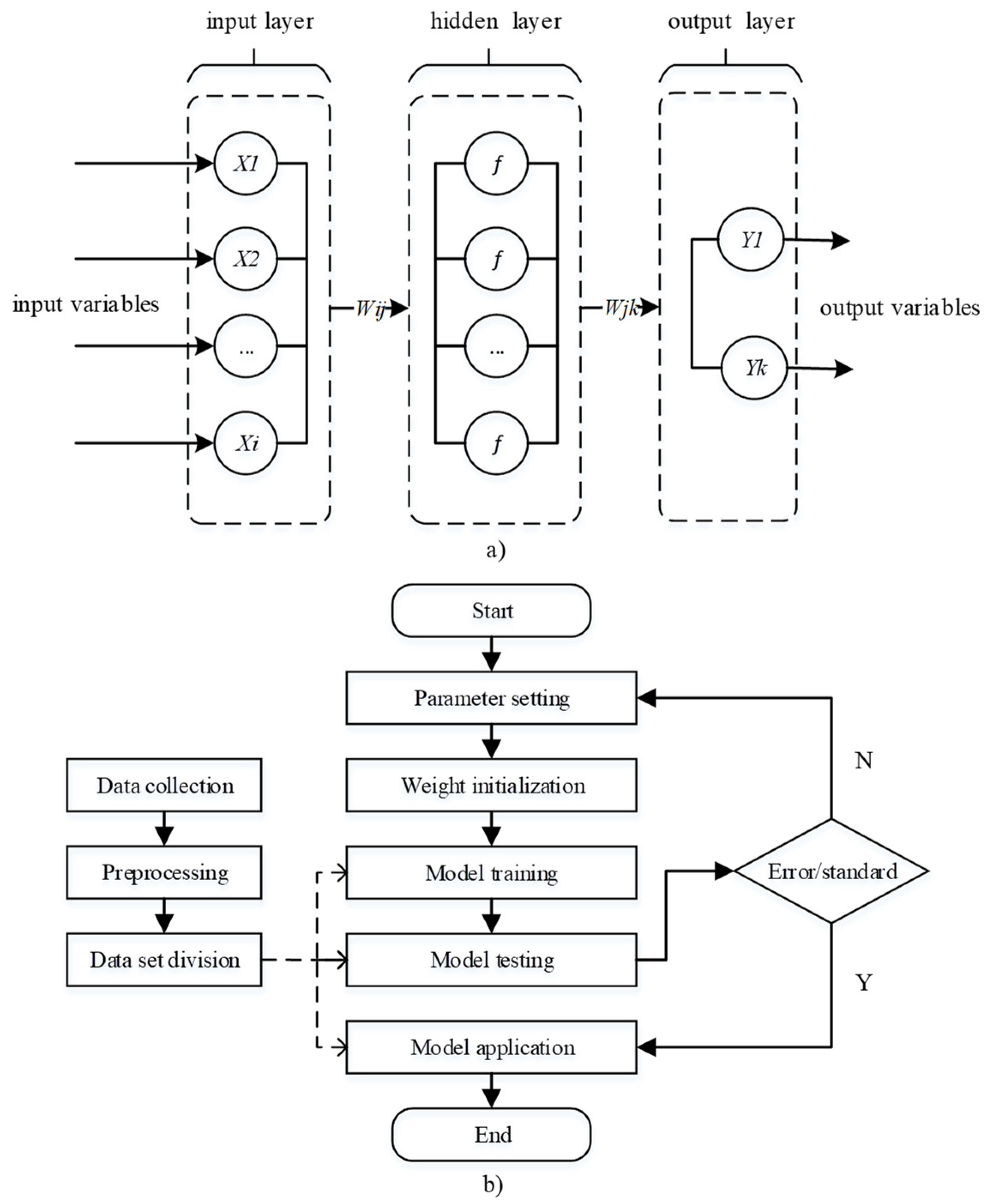
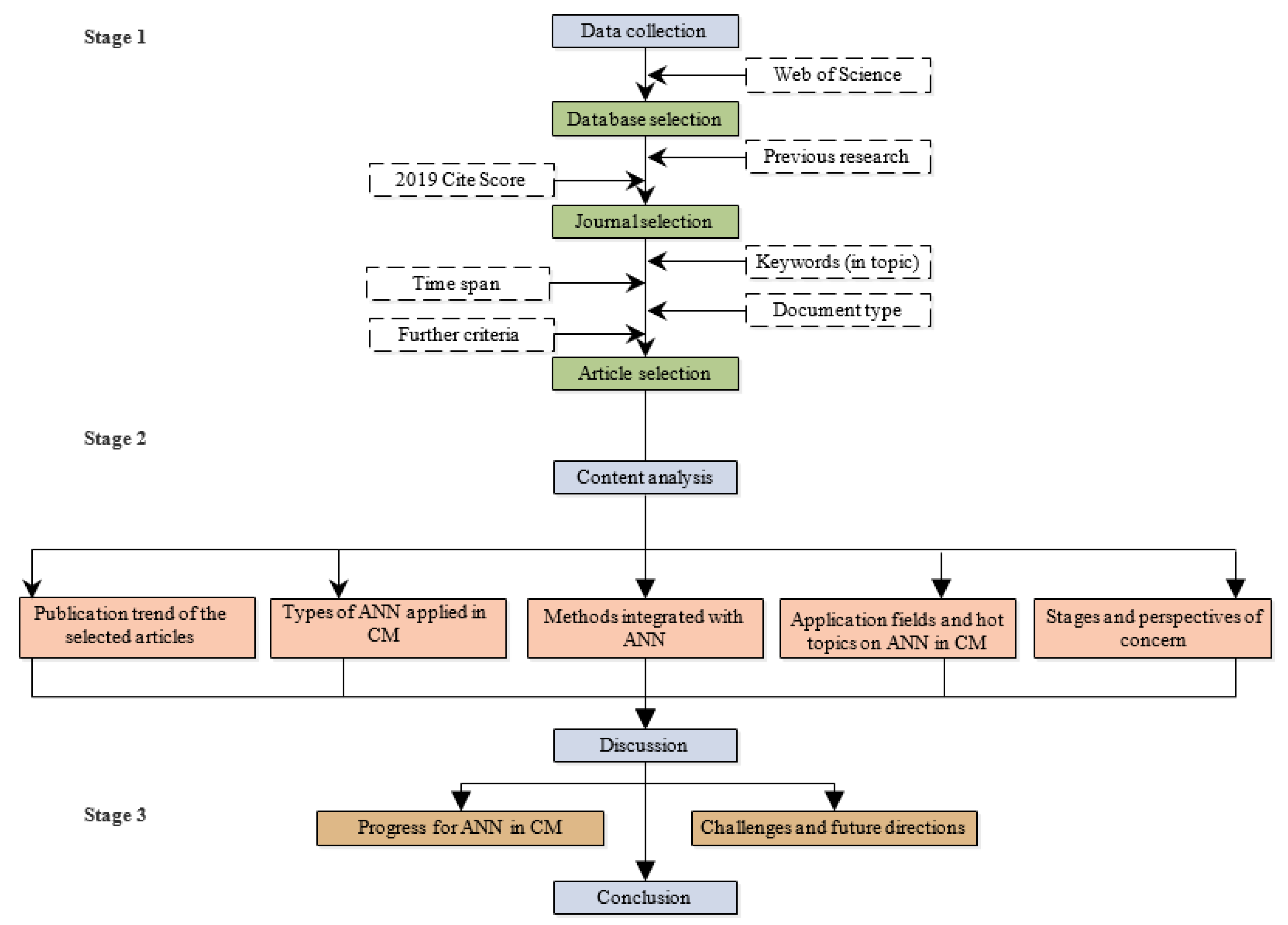
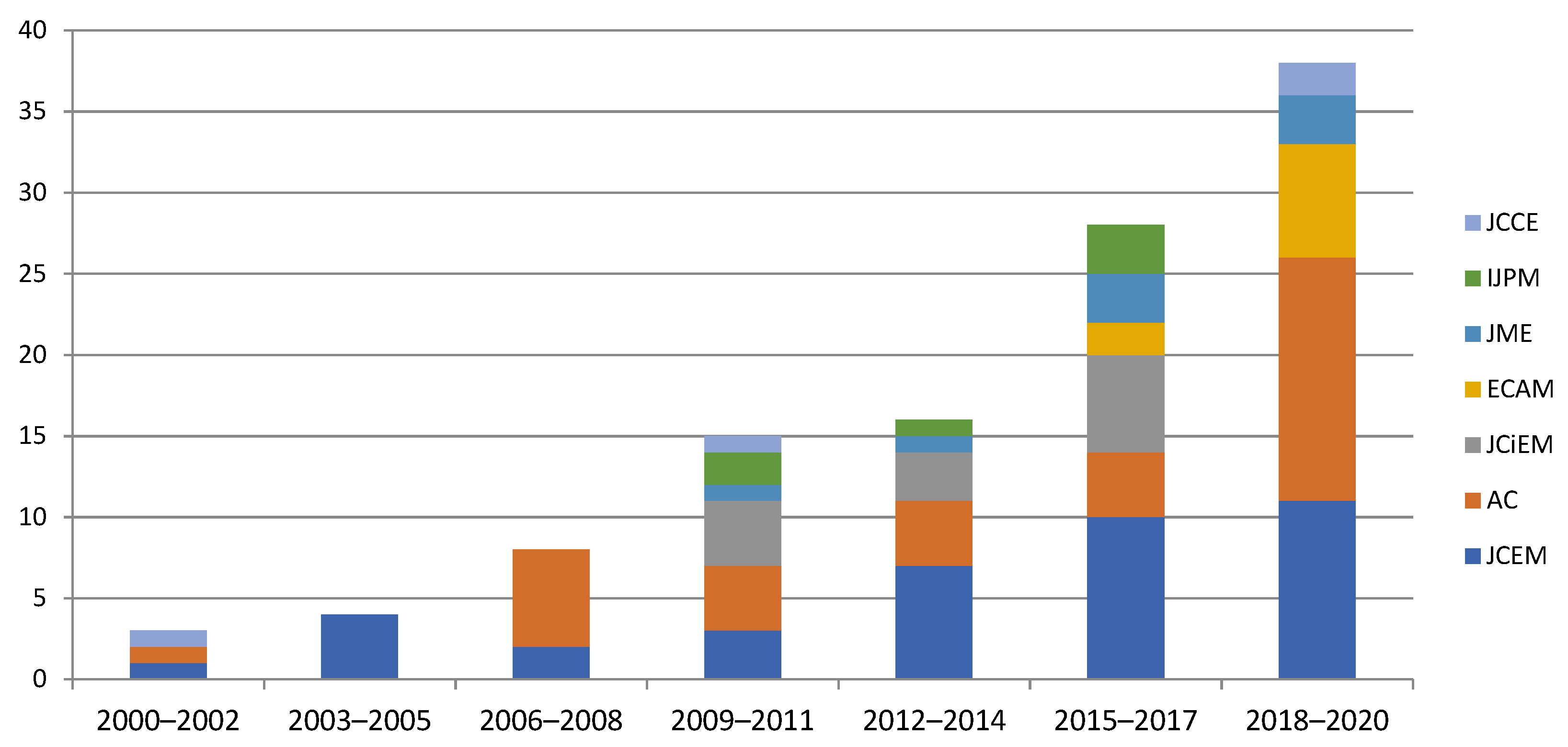
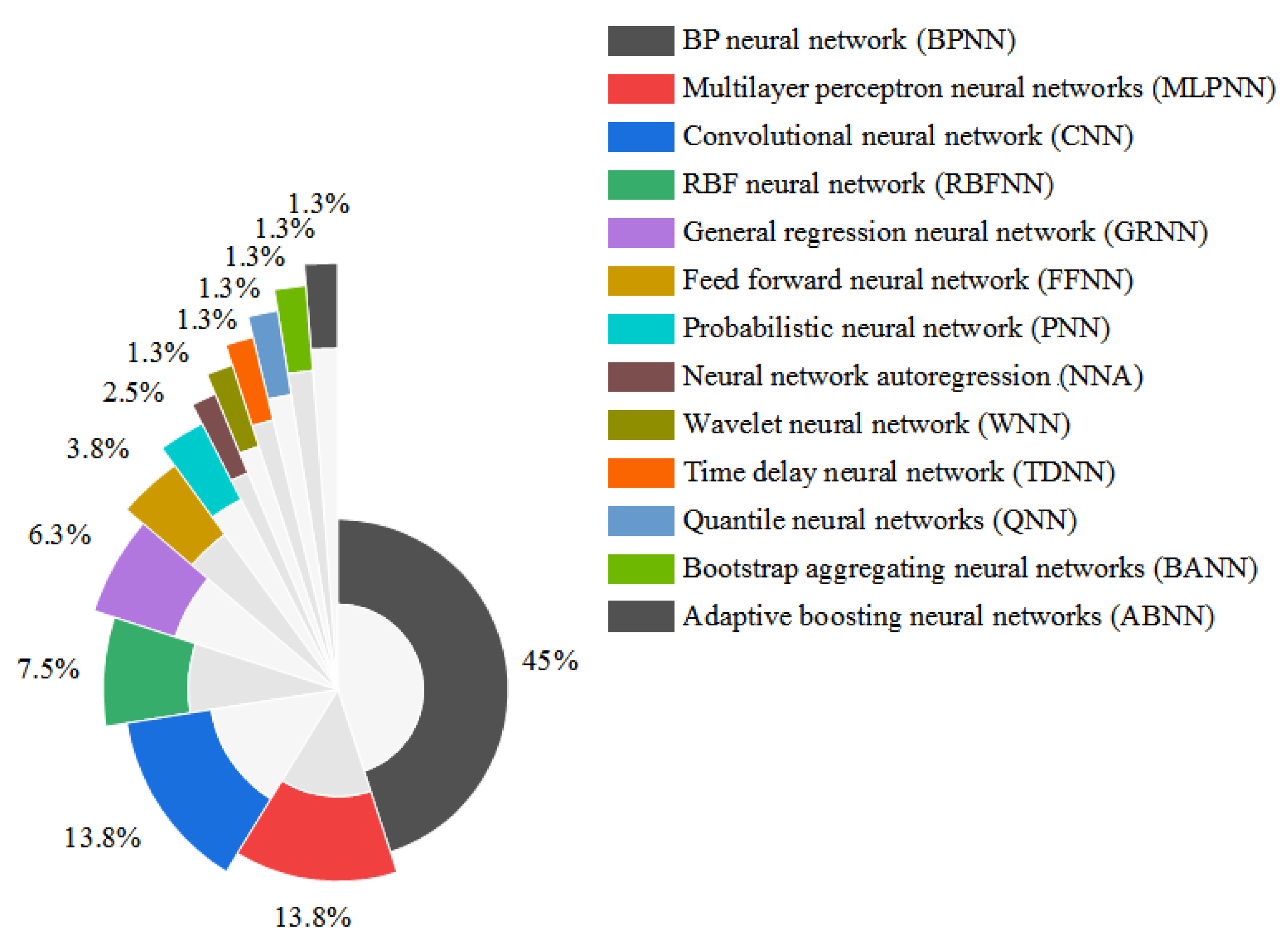

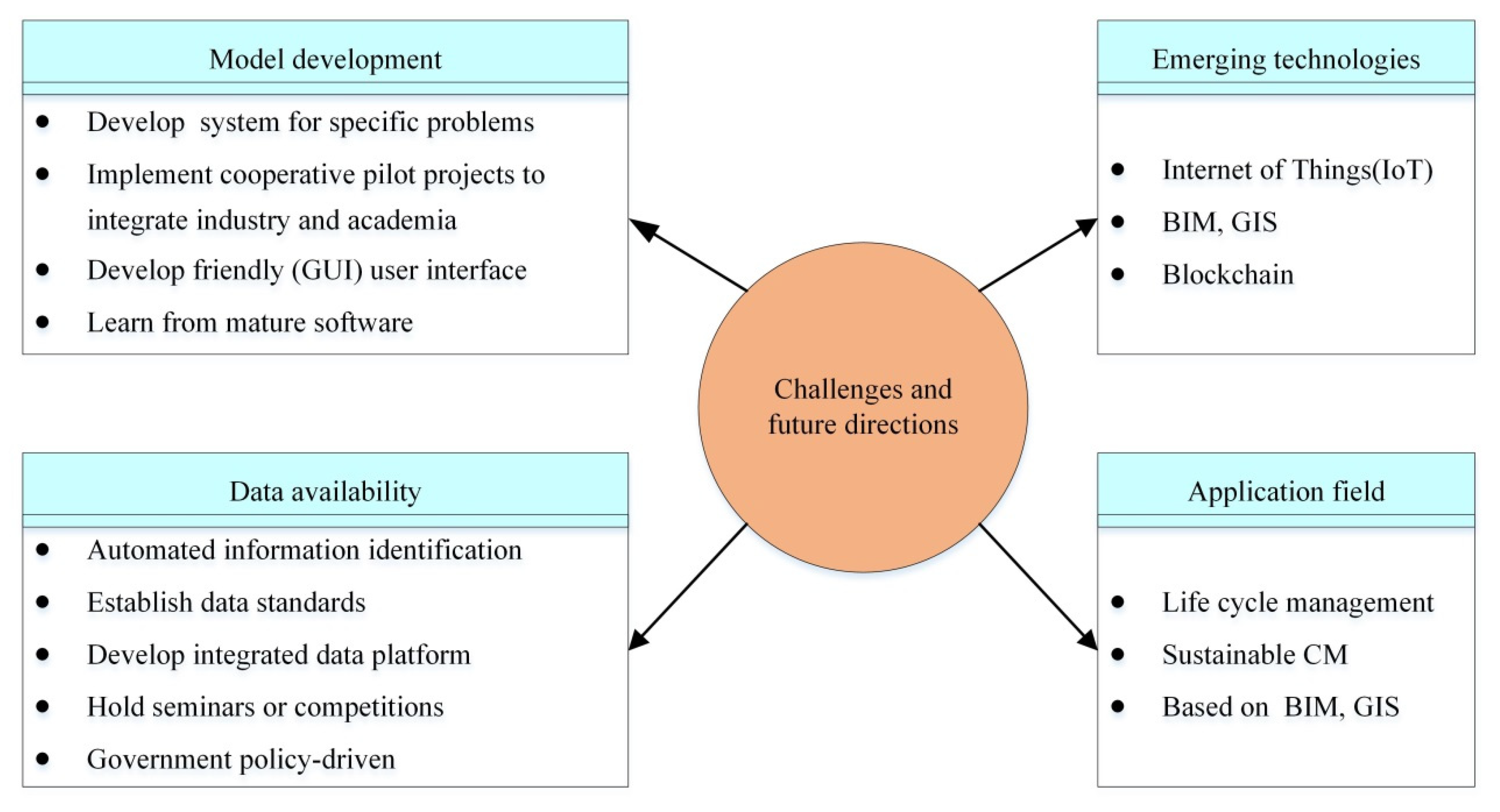

| Feature | Pros | Cons |
|---|---|---|
| Topology |
|
|
|
| |
| Ability |
|
|
|
| |
|
| |
|
|
| No. | Journal | Cite Score 2019 | No. of Paper |
|---|---|---|---|
| 1 | Journal of Construction Engineering and Management (JCEM) | 5.8 | 38 |
| 2 | Automation in Construction (AC) | 9.5 | 34 |
| 3 | Journal of Civil Engineering and Management (JCiEM) | 4.7 | 13 |
| 4 | Engineering, Construction and Architectural Management (ECAM) | 2.5 | 9 |
| 5 | Journal of Management in Engineering (JME) | 6.7 | 8 |
| 6 | International Journal of Project Management (IJPM) | 13.0 | 6 |
| 7 | Journal of Computing in Civil Engineering (JCCE) | 7.6 | 4 |
| Total | 112 |
| Type | Features | Weakness | Applicable Field |
|---|---|---|---|
| BPNN [10,51,52] | Gradient descent method. Nonlinear mapping function. Self-learning and adaptive. | Problem of slow convergence, over-fitting, and local optima. | Applied to prediction and classification tasks in CM: widely used to solve problems in 11 fields; see Table 4. |
| MLPNN [12,53] | Nonlinear mapping function. Global optimization. | Insufficient generalization ability. Poor performance in processing multidimensional data. | Applied to prediction and classification tasks in CM: claim prediction, cost prediction, classification of patent screening, classification of project decision. |
| CNN [15,54] | Sparse connectivity and weight sharing. Suitable for high-dimensional data. | Large amount of calculation, and high requirements for input data. | Applied to the image field in CM: safety risk identification at construction site, sewer image defect classification, equipment tracking and monitoring. |
| Code | Application Fields | Freq./ Percentage | Specific Topics | Freq. | Percentage |
|---|---|---|---|---|---|
| 1 | Cost | 26 23.21% | Project cost estimation | 13 | 11.61% |
| Materials prices prediction | 5 | 4.46% | |||
| Bid price prediction | 3 | 2.68% | |||
| Forecasting construction cost index | 2 | 1.79% | |||
| Usage and service cost estimation | 2 | 1.79% | |||
| Maintenance cost of equipment prediction | 1 | 0.89% | |||
| 2 | Performance | 18 16.07% | Corporate performance evaluation | 5 | 4.46% |
| Project performance evaluation | 11 | 9.82% | |||
| Industry performance evaluation | 2 | 1.79% | |||
| 3 | Safety | 13 11.61% | Worker safety behavior assessment | 10 | 8.93% |
| Accident analysis for construction safety | 2 | 1.79% | |||
| Safety climate prediction | 1 | 0.89% | |||
| 4 | Quality | 9 8.04% | Health monitoring of construction structure | 6 | 5.36% |
| Construction stability testing | 3 | 2.68% | |||
| 5 | Resource | 9 8.04% | Mechanical equipment management | 3 | 2.68% |
| Material management | 2 | 1.79% | |||
| Fund management | 2 | 1.79% | |||
| Patent technology management | 1 | 0.89% | |||
| Human resources management | 1 | 0.89% | |||
| 6 | Risk | 7 6.25% | Optimal risk allocation in projects | 3 | 2.68% |
| Multi-project resource conflict risk prediction | 3 | 2.68% | |||
| Prediction of financial contingency | 1 | 0.89% | |||
| 7 | Contract | 6 5.36% | Project dispute prediction and resolution | 3 | 2.68% |
| Prediction of project claim | 3 | 2.68% | |||
| 8 | Schedule | 6 5.36% | Project duration and time estimation | 4 | 3.57% |
| S-curve prediction, auxiliary schedule control | 2 | 1.79% | |||
| 9 | Procurement | 5/4.46% | Contractor prequalification and selection | 5 | 4.46% |
| 10 | Environment and sustainability | 4 3.57% | Energy consumption evaluation | 3 | 2.68% |
| Environment assessment | 1 | 0.89% | |||
| 11 | Other | 9 8.04% | Model or system development | 7 | 6.25% |
| Trend forecast | 2 | 1.79% |
| Research Topics | Input Variable | Description | References | Variable Ranking |
|---|---|---|---|---|
| Predicting construction cost | Total construction area | Above and below ground | [61,66,68,70] | 1 |
| number of floors | Above and below ground, building height | [61,68,70] | 2 | |
| project locality | Project location, location index | [66,70,71] | 3 | |
| Facility | Interior decoration, electromechanical infrastructure | [61,70] | 4 | |
| Market conditions | Price at the beginning of the project, economic variables and indexes | [66,70] | 5 | |
| Site conditions | Topography, ground conditions, soil condition | [61,70] | 6 | |
| Forecasting index/price | Corresponding data in previous | Material prices in the previous five days, price index of the last two quarters, etc. | [72,73,74] | 1 |
| Macroeconomic indicators | CPI, PPI, unemployment rate, GDP, foreign reserves, lending rate, etc. | [75,76] | 2 |
| Applications Fields | Project Level | Enterprise Level | Industry Level | |||
|---|---|---|---|---|---|---|
| Planning and Design | Bidding | Construction | Operation Maintenance | |||
| Cost | 16 | 3 | 3 | 0 | 1 | 3 |
| Performance | 2 | 0 | 9 | 0 | 5 | 2 |
| Safety | 0 | 0 | 13 | 0 | 0 | 0 |
| Quality | 0 | 0 | 2 | 7 | 0 | 0 |
| Resource | 1 | 0 | 5 | 1 | 1 | 1 |
| Procurement | 0 | 4 | 0 | 0 | 0 | 1 |
| Risk management | 0 | 0 | 3 | 0 | 4 | 0 |
| Contract | 0 | 0 | 6 | 0 | 0 | 0 |
| Schedule | 1 | 0 | 5 | 0 | 0 | 0 |
| Environment and sustainability | 1 | 0 | 0 | 3 | 0 | 0 |
| Other | 4 | 1 | 1 | 1 | 0 | 2 |
| Total | 25 | 8 | 47 | 12 | 11 | 9 |
| Progress | Research between 1989 and 2000 [17] | Research between 2000 and 2020 |
|---|---|---|
| Type of ANN | BPNN, RBFNN | BPNN, MLPNN, CNN, RBFNN, GRNN, PNN, NNA, WNN, TDNN, QNN, BANN, ABNN |
| Fields of research | cost, schedule, resource allocation, dispute prediction | cost, performance, safety, quality, resource, risk, contract, schedule, procurement, environment, and sustainability |
| Integratedalgorithm/method | GA, FL, Wavelets | GA, FL, Long Short-Term Memory, Wavelet, Clustering, K-Nearest Neighbors, Decision Tree, Case-based Reasoning, Support Vector Machine, Regression Analysis, Deep Learning method |
| Emerging Technologies | / | computer vision, smart sensor, smart bracelet, smart phone, done, video camera, natural language processing |
Publisher’s Note: MDPI stays neutral with regard to jurisdictional claims in published maps and institutional affiliations. |
© 2021 by the authors. Licensee MDPI, Basel, Switzerland. This article is an open access article distributed under the terms and conditions of the Creative Commons Attribution (CC BY) license (https://creativecommons.org/licenses/by/4.0/).
Share and Cite
Liu, S.; Chang, R.; Zuo, J.; Webber, R.J.; Xiong, F.; Dong, N. Application of Artificial Neural Networks in Construction Management: Current Status and Future Directions. Appl. Sci. 2021, 11, 9616. https://doi.org/10.3390/app11209616
Liu S, Chang R, Zuo J, Webber RJ, Xiong F, Dong N. Application of Artificial Neural Networks in Construction Management: Current Status and Future Directions. Applied Sciences. 2021; 11(20):9616. https://doi.org/10.3390/app11209616
Chicago/Turabian StyleLiu, Shicheng, Ruidong Chang, Jian Zuo, Ronald J. Webber, Feng Xiong, and Na Dong. 2021. "Application of Artificial Neural Networks in Construction Management: Current Status and Future Directions" Applied Sciences 11, no. 20: 9616. https://doi.org/10.3390/app11209616
APA StyleLiu, S., Chang, R., Zuo, J., Webber, R. J., Xiong, F., & Dong, N. (2021). Application of Artificial Neural Networks in Construction Management: Current Status and Future Directions. Applied Sciences, 11(20), 9616. https://doi.org/10.3390/app11209616








